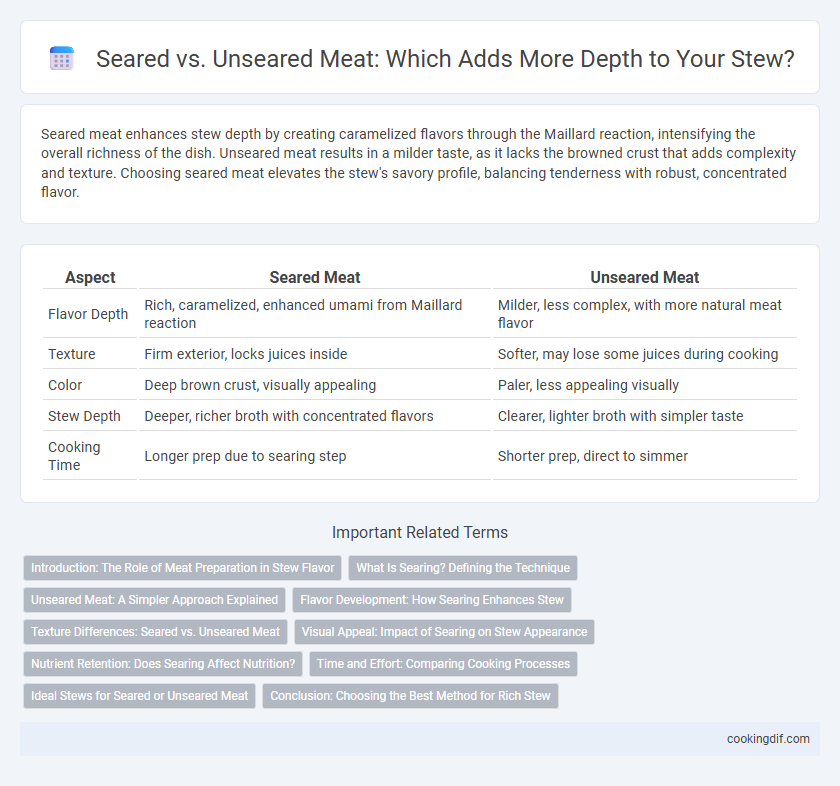Seared meat enhances stew depth by creating caramelized flavors through the Maillard reaction, intensifying the overall richness of the dish. Unseared meat results in a milder taste, as it lacks the browned crust that adds complexity and texture. Choosing seared meat elevates the stew's savory profile, balancing tenderness with robust, concentrated flavor.
Table of Comparison
| Aspect | Seared Meat | Unseared Meat |
|---|---|---|
| Flavor Depth | Rich, caramelized, enhanced umami from Maillard reaction | Milder, less complex, with more natural meat flavor |
| Texture | Firm exterior, locks juices inside | Softer, may lose some juices during cooking |
| Color | Deep brown crust, visually appealing | Paler, less appealing visually |
| Stew Depth | Deeper, richer broth with concentrated flavors | Clearer, lighter broth with simpler taste |
| Cooking Time | Longer prep due to searing step | Shorter prep, direct to simmer |
Introduction: The Role of Meat Preparation in Stew Flavor
Seared meat enhances stew depth by creating complex Maillard reaction flavors that intensify the dish's richness. Unseared meat releases moisture rapidly, which can dilute the stew's taste and result in a less pronounced flavor profile. Proper searing develops a robust foundation critical for savory, well-balanced stew.
What Is Searing? Defining the Technique
Searing is a high-heat cooking technique that rapidly browns the surface of meat, creating a flavorful crust through the Maillard reaction. This process enhances the depth and richness of a stew by locking in juices and developing complex flavors before slow cooking. Unseared meat, by contrast, lacks this caramelized exterior, resulting in a stew with a milder taste and less robust texture.
Unseared Meat: A Simpler Approach Explained
Unseared meat in stew retains a pure, rich flavor that allows the natural taste of the meat to shine through without the added complexity of searing. This simpler approach reduces preparation time and prevents the Maillard reaction's caramelization, resulting in a softer texture that absorbs the stew's broth more effectively. For home cooks seeking tender, melt-in-your-mouth stew, unseared meat offers a straightforward method that highlights the stew's depth through slow cooking alone.
Flavor Development: How Searing Enhances Stew
Searing meat before adding it to stew significantly enhances flavor development by creating a rich, caramelized crust through the Maillard reaction, which intensifies savory notes and complexity. This browning process locks in juices and adds depth that unseared meat lacks, resulting in a more robust and aromatic stew. Without searing, the stew can taste flat and less nuanced, as the meat releases moisture without the flavorful caramelized compounds.
Texture Differences: Seared vs. Unseared Meat
Seared meat develops a caramelized crust through the Maillard reaction, enhancing the stew's texture with a slightly firmer exterior and richer mouthfeel. Unseared meat remains tender but lacks the depth of flavor and subtle textural contrast provided by searing. The searing process not only intensifies taste but also helps retain moisture during slow cooking, resulting in a more complex and satisfying stew texture.
Visual Appeal: Impact of Searing on Stew Appearance
Searing meat for stew creates a rich, caramelized crust that enhances visual appeal with deep, browned hues and an appetizing texture contrast. Unseared meat tends to result in a paler, less visually dynamic stew, lacking the Maillard reaction's signature golden-brown coloration. The intense browning from searing not only improves appearance but also signals more robust flavor development in the final dish.
Nutrient Retention: Does Searing Affect Nutrition?
Searing meat before adding it to stew creates a flavorful crust through the Maillard reaction but may slightly reduce surface nutrient levels due to high heat exposure. Nutrient retention primarily depends on cooking duration and liquid medium, with prolonged simmering causing more leaching of water-soluble vitamins regardless of searing. Studies indicate searing does not significantly diminish the overall nutritional value of meat in stew, as minerals and proteins remain largely intact throughout the cooking process.
Time and Effort: Comparing Cooking Processes
Seared meat enhances stew depth by caramelizing surface proteins through the Maillard reaction, requiring an additional 10-15 minutes of concentrated effort before simmering. Unseared meat skips this step, reducing prep time but often resulting in a less complex flavor profile and lighter broth color. Balancing short-term efficiency against long-term flavor investment is crucial for optimal stew results.
Ideal Stews for Seared or Unseared Meat
Seared meat enhances stews by creating a rich, caramelized crust that deepens flavor through the Maillard reaction, making it ideal for hearty, slow-cooked recipes like beef bourguignon or Irish stew. Unseared meat is better suited for quicker stews or delicate recipes, such as chicken or vegetable-based stews, where a lighter broth and tender texture are preferred. Choosing seared or unseared meat impacts the stew's depth, with seared meat providing robust complexity and unseared meat maintaining subtle, natural tastes.
Conclusion: Choosing the Best Method for Rich Stew
Seared meat enhances stew depth by creating a complex Maillard reaction, intensifying flavor and adding a rich brown color. Unseared meat results in a milder, cleaner taste but lacks the savory complexity searing provides. For a deeply flavorful stew, seared meat remains the optimal choice to achieve maximum richness and aroma.
Seared vs Unseared meat for stew depth Infographic

 cookingdif.com
cookingdif.com